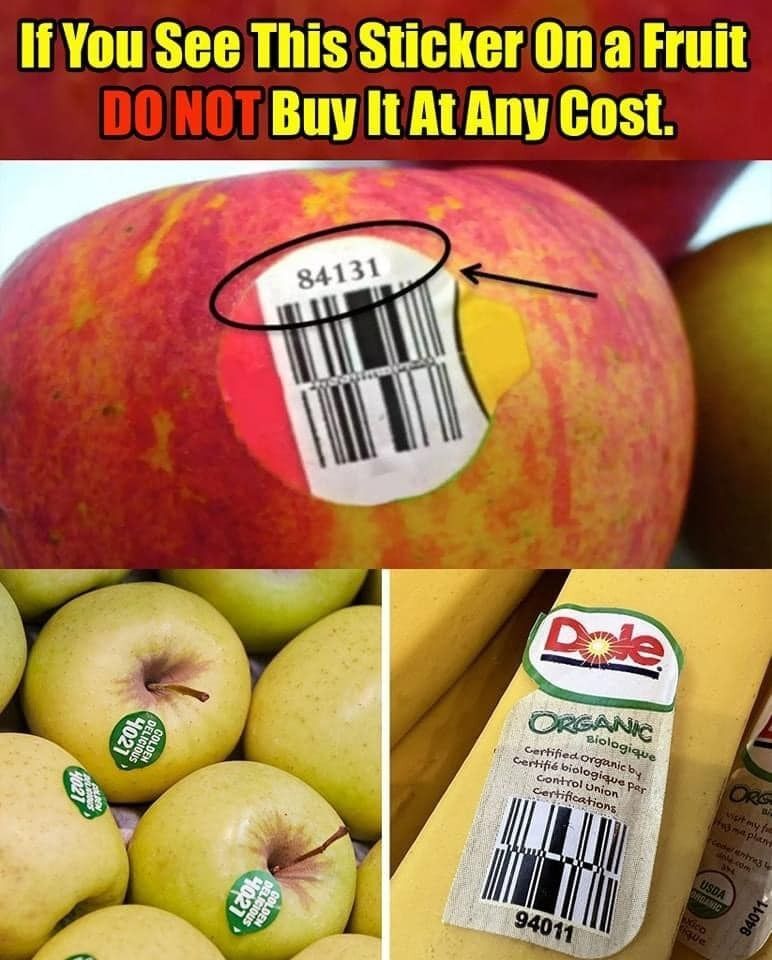You’ve probably taken off tons of stickers from fruits and veggies over the years. But have you ever thought about what those numbers really mean?
Many folks think they’re just codes for cashiers to use at checkout, but these numbers reveal important info for shoppers, showing how the item is grown!
The small stickers on fruit might seem boring, but each label shares an interesting story about how the fruit is made, its health effects, and its impact on nature.
Let’s explore what these labels mean so you can make smart choices about the fruit you eat!
Conventional fruit
Conventional fruit labels are for fruits grown using traditional farming techniques that often involve synthetic chemicals like fertilizers, pesticides, and herbicides. These methods are commonly used to boost production, protect crops, and lower overall costs.
- Use of synthetic chemicals: In conventional farming practices, chemicals such as pesticides and herbicides are used to keep fruits safe from pests and diseases. While this can increase crop yield, it may leave residues on the produce.
- Nutritional quality: Studies show mixed results on whether conventional produce is less nutritious than organic options. Harvard Health looked at a study that found “organics do have some safety advantages over conventional foods” but “nutritionally speaking they offer little extra.”
- Environmental impact: Conventional farming significantly affects nature due to reliance on chemical inputs which can cause soil damage, water pollution,and loss of biodiversity.
These fruits usually have a four-digit PLU (Price Look-Up) code starting with a three or four like 4011.
Genetically modified (GM) fruit
GMO fruits are those that have been genetically changed to add specific traits like pest resistance or better nutrition. This change happens at the DNA level aiming to improve the characteristics of the fruit for better growth and strength.
This type of produce could be key in feeding our growing population especially in areas with tough climates.
In America,the U.S. Food & Drug Administration (FDA) oversees all foods from genetically engineered plants ensuring they meet safety standards just like non-GM fruits.
- Genetic engineering: GM fruits go through DNA changes making them tougher against environmental issues such as drought or pests.
- Health & safety: Agencies like FDA & WHO say GM foods are safe to eat. However,some people choose not to eat GM foods because of possible long-term health risks and ethical worries.
- Environmental considerations: GM crops may lessen certain chemical uses,but there are still concerns about their effect on biodiversity & potential cross-contamination with non-GM crops.
GM fruits come with a five-digit PLU code starting with an 8,such as 84131. It’s important to know that in some places,GMO foods might not be clearly labeled making it hard for shoppers to spot them directly.
Organic fruit labels
Organic fruit tends to cost more so is it worth it? If you’re after higher production standards along with environmental benefits linked with organic methods then yes!
Labels on organic items tell consumers that they were grown using techniques focusing on natural processes while avoiding synthetic chemicals. Organic farming follows strict rules set by organizations ensuring soil health,biodiversity,and animal welfare standards.For many people ,organic products symbolize commitment towards personal well-being along side environmental care.
The U.S.Department of Agriculture (USDA) has an organic certification program requiring all organic food meet strict government guidelines.
“Produce can be called organic if certified having been grown in soil without prohibited substances applied three years before harvest.Prohibited substances include most synthetic fertilizers & pesticides,” says USDA.
- Chemical-free cultivation: Organic farming bans synthetic pesticides/fertilizers relying instead upon natural materials/techniques such as crop rotation , composting ,and biological pest control .
Higher nutritional value : Mayo Clinic states “some data shows possible health benefits from organics compared against conventionally produced food.” But more studies needed determine overall nutritional effects .
Environmental benefits : Organic practices support healthy soils conserve water encourage biodiversity .
Organic items carry a five-digit PLU code beginning with a nine,such as94011.Additionally ,organic produce often displays certification marks from recognized groups like USDA Organic or EU Organic confirming compliancewithorganicstandards .Understandingfruitlabels empowers consumers enabling choices aligningwithhealthandenvironmentalvalues.By recognizingthese labelsandtheirmeanings,youcanpickthefruitsbestforyourpreferencesandpriorities.
This info should help you make smarter decisions when choosing your next pieceoffruitatthe store!
Please share your thoughts below then pass this article onto friends so they too understand those tiny labels!

Leave a Reply